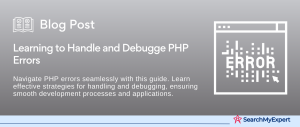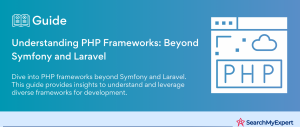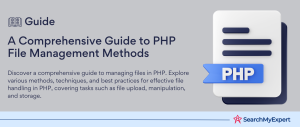PHP: Unveiling the Power of a Pioneering Scripting Language
What is PHP?
PHP, an acronym for “Hypertext Preprocessor,” stands as a hallmark in the world of web development. This open-source scripting language is ingeniously designed to embed within HTML, making it a cornerstone for building dynamic web pages. Unlike client-side languages like HTML or JavaScript, PHP code is executed on the server, sending only the output to the client. This unique attribute makes PHP a versatile tool for web developers seeking to create interactive, user-driven websites.
Why Web Development with PHP?
Opting for PHP in web development isn’t just a choice; it’s a strategic decision backed by numerous benefits. PHP’s seamless integration with various databases, compatibility with major operating systems, and ease of embedding into HTML sets it apart. Its widespread popularity is also due to its user-friendly nature, offering an accessible learning curve for beginners while still providing robust features for advanced developers.
Advantages of Using PHP
- Efficiency in Performance:
PHP scripts run with remarkable speed, owing to their server-side execution. This efficiency is vital for websites requiring regular content updates or handling high traffic. - Flexibility and Scalability: Whether you’re running a small blog or a large e-commerce site, PHP’s scalability meets the growing needs of your site effortlessly.
- Cost-Effective and Accessible:
Being open-source, PHP is freely available, reducing development costs. Plus, its widespread use has led to a vast community, offering extensive support and resources. - Security:
With advanced features for data encryption and user authentication, PHP provides robust security measures to protect websites from potential threats.
Common Applications of PHP
- Content Management Systems (CMS): Platforms like WordPress, Drupal, and Joomla utilize PHP, offering customizable and powerful solutions for website management.
- E-commerce Platforms:
PHP’s adaptability makes it ideal for developing bespoke e-commerce sites, integrating with various payment gateways and databases. - Web Applications: From social networking sites to online forums, PHP’s dynamic capabilities enable developers to build feature-rich web applications.
Setting Up Your Development Environment for PHP: A Step-by-Step Guide
Embarking on your PHP development journey requires setting up an efficient and robust development environment. This setup is crucial as it forms the foundation upon which all your PHP coding and website development will take place. In this section, we’ll guide you through choosing the right text editor or Integrated Development Environment (IDE), installing a web server, and getting comfortable with your editor and server.
Choosing a Text Editor/IDE
When it comes to PHP development, the choice of a text editor or an IDE can significantly impact your productivity and coding experience. An IDE typically offers more comprehensive features like debugging tools, syntax highlighting, and code suggestions, which are invaluable for both beginners and seasoned developers. Here are some popular options:
- Visual Studio Code:
A lightweight, yet powerful source code editor from Microsoft. It supports PHP and offers features like syntax highlighting intelligent code completion, and integrated Git control. - PHPStorm: Tailored for PHP, this IDE by JetBrains offers deep code understanding, top-notch coding assistance, and support for all PHP tools and major frameworks.
- Sublime Text:
Known for its speed and efficiency, Sublime Text is a sophisticated text editor for code, markup, and prose. It’s customizable and has a variety of PHP-related packages available. - NetBeans: A free and open-source IDE, NetBeans supports PHP and offers features like code templates, debugging, and easy navigation for large code bases.
Installing a Web Server (Apache, Nginx, XAMPP/WAMP)
To run PHP scripts, you’ll need a local server environment. Here’s how to set up some popular options:
- Apache or Nginx:
These are the most commonly used web servers for PHP development. Apache is known for its wide range of features and compatibility, while Nginx offers high performance and resource efficiency. - XAMPP/WAMP:
For beginners, XAMPP (for all major operating systems) or WAMP (for Windows) are excellent choices. These packages include Apache, MySQL, PHP, and Perl, making them a one-stop solution for setting up a development environment.
Learning the PHP Basics: Your Gateway to Coding Mastery
Venturing into the realm of PHP programming requires a solid grasp of its fundamental concepts. In this section, we’ll dive into the basics of PHP syntax, control flow statements, functions, and data structures. These elements form the backbone of PHP scripting, enabling you to create dynamic and interactive web pages.
Syntax Basics: Variables, Operators, Data Types
PHP syntax is the set of rules that defines how you write your code. Understanding these basics is crucial for writing efficient and error-free PHP scripts.
- Variables: In PHP, a variable starts with the $ sign, followed by the name of the variable. For example, $name = “John”; Here, $name is a variable storing the value “John”.
- Operators:
PHP uses operators to perform operations on variables and values. These include arithmetic operators like +, -, *, /, and logical operators like && (and), || (or), ! (not). - Data Types: PHP supports several data types, including:
- Strings: Represented by text within quotes. Example: $text = “Hello World!”;
- Integers: Non-decimal numbers. Example: $age = 30;
- Floats (or doubles): Numbers with a decimal point. Example: $price = 10.99;
- Booleans: Represents two possible states: TRUE or FALSE.
Mastering HTML and CSS with PHP: Creating Dynamic and Stylish Web Pages
In the world of web development, understanding the interplay between HTML, CSS, and PHP is crucial. This combination allows developers to create web pages that are not only functional but also aesthetically pleasing. In this section, we’ll delve into understanding HTML structure and basic tags, integrating PHP within HTML documents, and employing CSS to style your web pages alongside PHP.
Understanding HTML Structure and Basic Tags
HTML (HyperText Markup Language) is the standard markup language used to create web pages. A basic understanding of HTML is essential for any web developer, especially when working with PHP.
- HTML Basics:
HTML documents are made up of tags, which are used to define and organize the content of a web page. For example, <p> is used for paragraphs, <h1> to <h6> for headings, <a> for links, and <img> for images. - Document Structure:
Every HTML document has a standard structure that includes <!DOCTYPE html>, <html>, <head>, and <body> sections. - Forms in HTML:
Crucial for PHP, forms (<form> tag) are used to collect user input. PHP can process this input and perform actions like database queries or data validation.
Integrating PHP Code within HTML Documents
PHP can be integrated directly into HTML documents. This integration is what makes PHP such a powerful tool for creating dynamic web content.
- Embedding PHP:
PHP code is embedded in HTML documents using the <?php … ?> tags. You can insert PHP code anywhere in your HTML document. - Outputting HTML with PHP:
PHP can be used to output HTML content dynamically. For example, using echo or print statements within PHP tags. - Example:
Here’s a simple example of integrating PHP with HTML:
Styling Your Web Pages with CSS Alongside PHP
CSS (Cascading Style Sheets) is used to control the layout and appearance of HTML elements on a web page. When used with PHP, you can dynamically change styles.
- Inline and External CSS: CSS can be added directly into HTML tags using the style attribute (inline CSS) or linked as an external file using the <link> tag.
- Dynamic Styling with PHP:
PHP can be used to apply different CSS styles under certain conditions. For example, changing the background color based on user input or time of day.
Working with Forms and User Input in PHP: Capturing, Processing, and Validating Data
Forms are the backbone of user interaction in web applications. PHP, with its versatile features, provides an efficient way to handle forms. This step in your PHP learning journey will focus on creating HTML forms, processing form data with PHP, and ensuring the validity and security of user input.
Creating HTML Forms to Capture User Data
HTML forms are pivotal for gathering data from users. Here’s how to create them effectively:
- Form Syntax:
A typical form in HTML uses the <form> tag with essential attributes like action (the PHP file to process the data) and method (GET or POST). - Form Elements: Include input fields like text (<input type=”text”>), email (<input type=”email”>), and submit buttons (<input type=”submit”>).
- Organizing Forms: Use labels (<label>) for accessibility and tables or CSS for layout.
Processing Form Data with PHP Scripts
After a user submits a form, PHP scripts come into play to process the data.
- Retrieving Data: Use the global arrays $_POST or $_GET in PHP to fetch form data. The choice depends on the method used in the form.
- Server-Side Scripting: Always process form data on the server side for security and reliability.
Validating User Input for Security and Accuracy
Validating user input is crucial to prevent security vulnerabilities and ensure data integrity.
- Input Sanitization:
Use PHP functions like htmlspecialchars() to prevent XSS attacks and filter_var() for validating and sanitizing inputs. - Validation Techniques:
Check if fields are empty, verify email format, and use regular expressions for pattern matching. - Error Messages: Provide clear feedback to users if their input doesn’t meet the criteria.
Connecting to Databases with PHP: Mastering MySQL for Dynamic Web Solutions
In the realm of web development, the ability to interact with databases is crucial. PHP’s compatibility with MySQL, a widely used relational database management system, allows for the creation of dynamic and data-driven web applications. This section covers the basics of relational databases, setting up and connecting to a MySQL database, performing CRUD operations, and querying databases using PHP.
Understanding the Basics of Relational Databases
Relational databases store data in tables, which are connected through relationships. This structure allows for efficient storage, retrieval, manipulation, and management of data.
- Tables and Columns:
Data is stored in tables, which consist of columns (attributes) and rows (records). - Primary Keys:
Each table has a primary key, a unique identifier for each record. - Foreign Keys: These keys link tables together, enabling the creation of relationships between different data sets.
Setting Up and Connecting to a MySQL Database
To utilize MySQL with PHP, you first need to set up a MySQL database and then establish a connection using PHP.
- Installing MySQL: Ensure MySQL is installed on your server. Tools like XAMPP or WAMP provide an easy setup for MySQL.
- Creating a Database and Tables: Use MySQL commands or a tool like phpMyAdmin to create your database and tables.
Deploying Your Website and Expanding Your Skills: A Comprehensive Guide
The journey of web development doesn’t end with just writing code. Bringing your PHP website to life involves understanding web hosting, choosing domain names, and deploying your website online. Furthermore, the ever-evolving nature of web technology means there’s always more to learn. This section will guide you through these pivotal steps and suggest ways to continue expanding your PHP development skills.
Understanding Web Hosting and Domain Names
Before your website can go live, understanding the basics of web hosting and domain names is crucial.
- Web Hosting: This service allows you to store your website files on a server, making them accessible to users online. There are various types of hosting services, including shared hosting, VPS (Virtual Private Server), and dedicated servers.
- Choosing a Host:
Look for reliability, speed, customer support, and scalability. Popular hosting providers include Bluehost, SiteGround, and HostGator. - Domain Names:
Your website’s domain name is its unique address on the internet. Choose a name that is memorable, concise, and reflective of your website’s purpose. - Domain Registration:
Services like GoDaddy, Namecheap, or Google Domains allow you to register your chosen domain name.
Deploying Your Website Online
Taking your PHP website from development to live on the internet involves several key steps.
- Uploading Files: Use FTP (File Transfer Protocol) clients like FileZilla to upload your PHP files and assets to your hosting server.
- Configuring Databases: If your site uses a database, export your local database and import it to your hosting provider’s database server.
- Testing:
Once live, thoroughly test your website to ensure all features work as expected in the live environment.
Continuing Your Learning Journey: Frameworks, Advanced APIs, Security
Web development is a field of continuous learning. As you grow your skills, consider delving into these advanced areas:
- Frameworks: Frameworks like Laravel for PHP can speed up development and provide robust features. They encourage using best practices and can simplify complex tasks.
- Advanced APIs:
Learning to integrate third-party APIs adds functionality to your sites, like payment processing with Stripe or PayPal, or adding maps with Google Maps API. - Security: Understanding web security principles is critical. Learn about common vulnerabilities like SQL injection, XSS (cross-site scripting), and CSRF (Cross-Site Request Forgery) and how to protect against them.
- Continuous Learning:
Follow blogs, join forums, participate in webinars, and attend conferences to stay updated with the latest trends and best practices in web development.
Conclusion:
Our comprehensive journey through PHP for web development has equipped you with the knowledge and skills necessary to create dynamic and robust websites. From understanding the basics of PHP, setting up your development environment, and mastering HTML and CSS integration, to handling forms and user inputs, connecting to MySQL databases, and finally deploying your website – each step has been a building block towards becoming a proficient PHP developer.
Remember, the field of web development is ever-evolving, and staying updated with the latest trends, technologies, and best practices is crucial. Continuous learning, experimenting with new techniques, and building projects are key to advancing your skills and keeping your work relevant and impactful.
Redefine your web solutions with PHP Development Service Firms.
Table of Contents
Toggle






